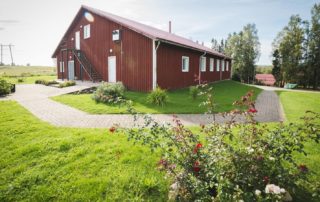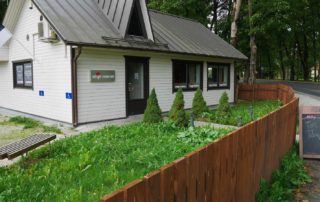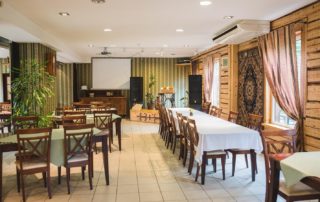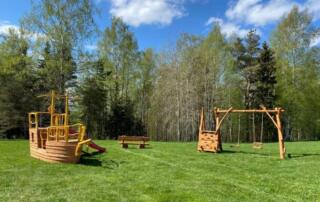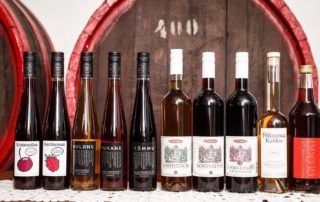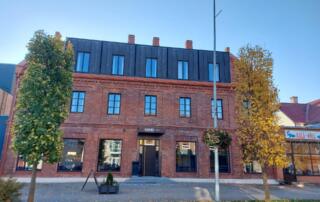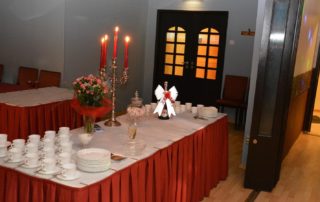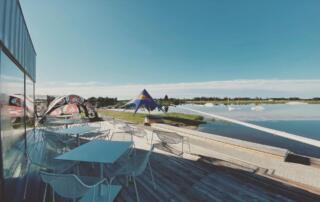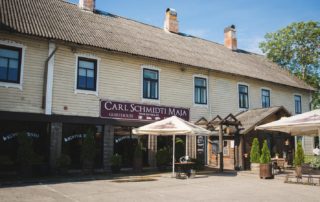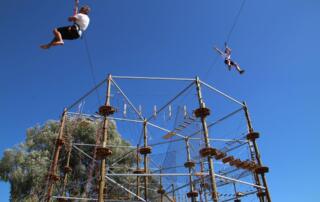The Seminar Rooms of the Voore Guesthouse
The Voore Guesthouse has the perfect atmosphere and facilities for organising training courses, conferences, seminars, meetings and promotional or other business events. The furniture and equipment can be placed according to the client's needs, and we offer WiFi, an illuminated parking lot, catering, reasonably priced accommodation and a range of both relaxing and invigorating activities.
Café O
A cosy and comfortable café located near historic Põltsamaa castle. Come and enjoy great food and company on our outdoor terrace or in our snug and warm café. All families, groups and passers-by whose mind and body needs some replenishing are welcome.
Seminar rooms at the Village Elder Carl Schmidt’s House
Village Elder Carl Schmidt's House has two rooms for seminars and other meetings. The hall on the first floor accommodates 100 people and there's also a bar. The cozy fireplace hall on the second floor accommodates 26 people.
Aruküla hill recreation area
There is a lovely recreation area on Aruküla hill in Kaarepere which is perfect for families, friends, and larger groups. There is a playground with swings and a slide, especially loved by younger children. You can rest under the shelter or on benches or your own picnic blanket. Barbecue facilities are also available on site. Visitors can also play disc golf (there is a rental point). The Struve Geodetic Arc is also located in the recreation area. The view of Vooremaa from the hill is magnificent and there is plenty of room for camping.
Põltsamaa Wine Cellar
Põltsamaa Wine Cellar has become one of the town's true tourist magnets. Here you can taste and buy all the wines from the local wine selection. In summer 2023 an exquisite restaurant called Oberpahlen was opened near the cellar. Come and enjoy wines from Põltsamaa and other places of Estonia as well as delicious food from the restaurant menu. In addition, the cellar offers wine tasting packages for groups including either three or five wines.
Coop Hotel
Coop Hotel is located on the main street of Jõgeva, in the city centre, in a house with a dignified history. It all started almost 100 years ago in 1919, when the Jõgeva Economic Union was formed – the goal was to open a main store in the town.Coop Hotel opened its doors in September 2021, continuing the long history of the house. The hotel has rooms for every taste. You can choose between single and double rooms. One room has been specially designed for people with reduced mobility. In addition, guests staying with us can go to the sauna [...]
Restaurant Kosmos
The restaurant consists of two parts: an 80-seat main dining room and a separate private dining room for up to 35 guests. The main dining room offers a cosy atmosphere and WiFi. The small dining room is suitable for smaller gatherings booked in advance (birthdays, company parties).
W Café
We are located in WPark - Põltsamaa wakepark and we offer delicious dishes for every taste. Both WPark guest and people from the surrounding area are welcome. In our menu you can find fries, burgers, steaks, soups, daily specials, and more. The menu also includes pastries, cakes, coffee and cocktails. Lively concerts and parties take place on the café's terrace in wonderful summer evenings. During the off-season, we offer a catering service and room rental with a sauna. We offer breakfast porridge in the café, Mon-Fri at 9:30-11:30. Daily specials are available Mon-Fri from 12:00.
The house of rural town elder Carl Schmidt
This cafe, situated in the heart of Põltsamaa, provides catering to up to 100 people (with group menus available). Daily soups and specials are also offered. Live music evenings are held here from time to time, and in the summer you can enjoy the fine weather on the terrace, which seats up to 30.
Põltsamaa Adventure Park
Põltsamaa Adventure Park is located in WPark, a summer mecca that offers active holidays, adventure, and fun water sports. Our adventure park is built on 9-metre-high pillars, which makes it one of the most unique adventure parks in Estonia. Climbing is done floor by floor, and each new level brings more excitement and challenges. There are 60 platforms in total and at the end there's a 130 m long zipline to the small island on Lake Kamari. One of the advantages when coming with friends, family or colleagues is that you can stay together and support each other while climbing. [...]

